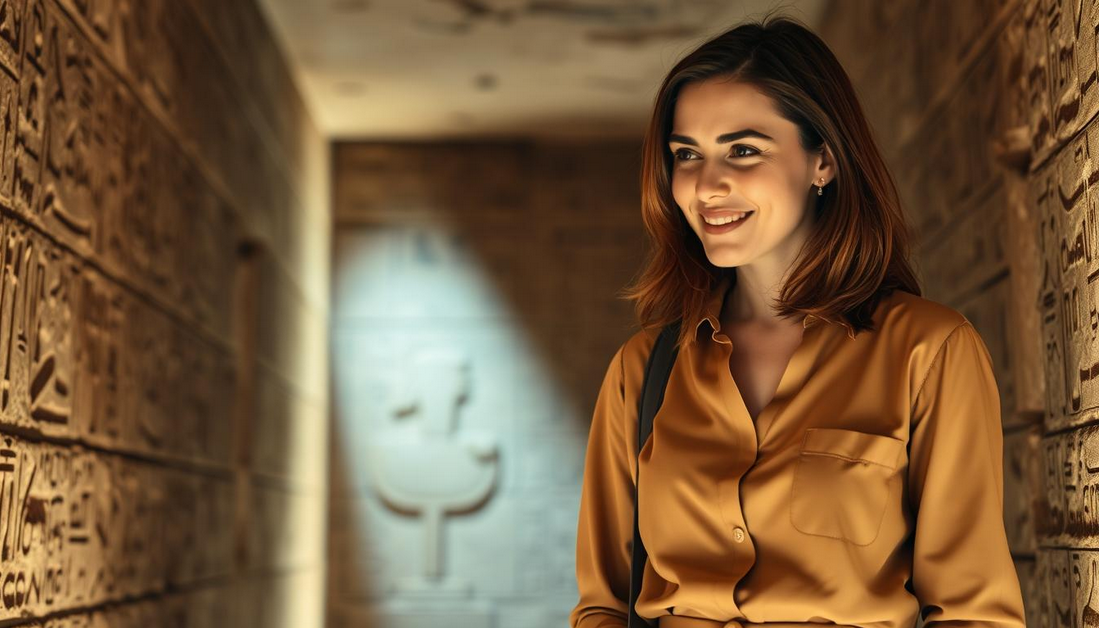What Secrets Lie Beneath Cairo’s Ancient Streets?
The city of Cairo is a treasure trove of history, with its ancient streets holding secrets that have been hidden for centuries. As you wander through the historic neighborhoods, you can’t help but wonder what lies beneath the surface.
- The Layered History of Cairo: A City Built Upon Cities
- From Memphis to Al-Qahira: The Evolution of Egypt’s Capital
- The Geological and Archaeological Timeline
- Discovering Cairo’s Ancient Streets: The First Excavations
- Early Archaeological Pioneers in Cairo
- Accidental Discoveries During Modern Construction
- The Birth of Urban Archaeology in Egypt
- The Forgotten City of Fustat
- Egypt’s First Islamic Capital
- The Archaeological Treasures of Fustat
- Connecting Ancient Streets to Modern Cairo
- Underground Coptic Cairo: Christian Heritage Beneath the Surface
- The Hanging Church and Its Underground Foundations
- Ancient Coptic Crypts and Catacombs
- Preserving Christian History in a Muslim City
- The Hidden Wonders of Islamic Cairo’s Ancient Streets
- Subterranean Structures of the Fatimid Era
- Mamluk Underground Chambers and Passages
- Ottoman Contributions to Cairo’s Underground Landscape
- Beneath the Citadel: Military Secrets Underground
- The Mysterious Tunnels of Al-Muizz Street
- Connecting Palaces and Mosques: The Underground Network
- Commercial Spaces Beneath the Famous Street
- Recent Discoveries Along Cairo’s Most Historic Thoroughfare
- Modern Excavation Challenges in a Living City
- Balancing Development and Preservation
- Technological Innovations in Urban Archaeology
- Legal and Ethical Considerations
- Experiencing Cairo’s Underground Treasures as a Visitor
- Accessible Archaeological Sites Beneath the City
- Guided Tours of Underground Cairo
- Photography and Documentation Tips
- Conclusion: The Continuing Story of Cairo’s Subterranean Past
- FAQ
- What are the most significant historical sites to explore in Cairo’s ancient streets?
- What lies beneath Cairo’s ancient streets?
- How has Cairo’s history been shaped by its previous civilizations?
- What are some of the challenges faced by archaeologists excavating in modern Cairo?
- Can visitors explore Cairo’s underground archaeological sites?
- What are some tips for capturing the best photographs of Cairo’s underground treasures?
- How can one experience the history of Cairo’s ancient streets?
- What is the significance of Fustat in Cairo’s history?
- Are there any recent discoveries in Cairo’s archaeological sites?

Cairo’s rich history is palpable as you explore the city’s historic landmarks. From the majestic mosques to the bustling markets, every corner reveals a piece of the city’s fascinating past.
As we delve into the ancient cairo history, you’ll discover the cairo hidden treasures that make this city so unique.
Key Takeaways
- Explore the hidden historical treasures beneath Cairo’s ancient streets.
- Discover the significance of Cairo’s historic landmarks.
- Uncover the secrets of ancient Cairo’s history.
- Learn about the cultural importance of Cairo’s hidden treasures.
- Understand the allure of Cairo’s ancient streets.
The Layered History of Cairo: A City Built Upon Cities
The city’s landscape is a palimpsest of successive cultures and empires, each leaving an indelible mark on its architecture, culture, and identity. Cairo, one of the oldest cities in the world, has been a witness to the rise and fall of numerous civilizations.

Cairo’s history is a complex narrative that spans millennia, with its roots tracing back to ancient Memphis, one of Egypt’s earliest capitals. The evolution of Cairo is intricately linked to the evolution of Egypt itself, with various dynasties and rulers contributing to its growth.
From Memphis to Al-Qahira: The Evolution of Egypt’s Capital
The journey from Memphis to Al-Qahira (Cairo) is a testament to the dynamic nature of Egyptian history. Memphis, the ancient capital during the Old Kingdom, laid the foundation for subsequent capitals, including Thebes and Fustat. The establishment of Al-Qahira by the Fatimid dynasty in the 10th century marked a significant turning point, as it became the nucleus of modern Cairo.
The transition from ancient capitals to the modern city involved the accumulation of cultural, architectural, and archaeological layers. Each era contributed to the rich tapestry of Cairo’s history, making it a city of cairo archaeological wonders.
The Geological and Archaeological Timeline
Cairo’s cairo history mysteries are also tied to its geological and archaeological timeline. The city’s location on the Nile has made it a hub of human activity for millennia. Archaeological excavations have uncovered layers of habitation, revealing a timeline that stretches from prehistoric times to the present day.
The cairo underground tombs and other subterranean structures hold secrets of the city’s past, including the ancient Egypt secrets cairo that are slowly being unearthed by archaeologists. These discoveries not only shed light on historical events but also provide insights into the lives of ordinary people who lived in these ancient civilizations.
Understanding the geological and archaeological timeline is crucial for appreciating the complexities of Cairo’s history. It highlights the city’s role as a cultural and political center throughout the ages, making it a treasure trove of cairo archaeological wonders.
Discovering Cairo’s Ancient Streets: The First Excavations
Beneath Cairo’s bustling streets lies a complex network of ancient pathways and structures, revealed through years of archaeological excavations and discoveries. The city’s rich history is layered, with each era leaving its mark on the urban landscape.

Early Archaeological Pioneers in Cairo
The exploration of Cairo’s ancient streets began with pioneering archaeologists who ventured into the unknown, driven by curiosity and a passion for uncovering the past. Their work laid the foundation for modern archaeological practices in Egypt.
One such pioneer was Gaston Maspero, who initiated significant excavations in the late 19th century. His efforts not only uncovered artifacts but also highlighted the importance of preserving cultural heritage.
Accidental Discoveries During Modern Construction
As Cairo underwent modernization, numerous construction projects inadvertently uncovered ancient structures and artifacts. These accidental discoveries often provided valuable insights into the city’s past, revealing hidden sites beneath the bustling streets.
For instance, during the construction of a new metro line, workers stumbled upon ancient tunnels and chambers, shedding light on Cairo’s historical infrastructure.
The Birth of Urban Archaeology in Egypt
The accumulation of these discoveries led to the development of urban archaeology as a distinct field in Egypt. This discipline focuses on the archaeological exploration of urban areas, balancing modern development with the preservation of historical sites.
| Year | Event | Significance |
|---|---|---|
| 1850s | Gaston Maspero’s Initial Excavations | Lay the groundwork for modern archaeology in Cairo |
| 1900s | Accidental discoveries during construction | Reveal hidden sites and ancient structures |
| 1980s | Establishment of urban archaeology as a field | Formalize the study and preservation of urban historical sites |
The journey of discovering Cairo’s ancient streets is ongoing, with each excavation and discovery adding to our understanding of this ancient city’s mysteries.
The Forgotten City of Fustat
Beneath the bustling streets of modern Cairo lies the forgotten city of Fustat, a historical gem waiting to be unearthed. Fustat, founded in 641 AD, was Egypt’s first Islamic capital, playing a crucial role in the country’s transition into an Islamic society.
Egypt’s First Islamic Capital
Fustat was more than just a city; it was the cradle of Islamic Egypt. Its establishment marked the beginning of Islamic rule in the region, influencing not only Egypt but the wider Mediterranean world. The city’s strategic location on the Nile made it a hub for trade, culture, and learning.

The Archaeological Treasures of Fustat
Excavations at Fustat have uncovered a treasure trove of archaeological findings, including pottery, coins, and manuscripts that shed light on the daily lives of its inhabitants. These discoveries highlight the city’s significance as a center of commerce and culture during the Islamic period.
The archaeological sites in Fustat are a window into the past, revealing the rich history of Islamic civilization in Egypt. By studying these sites, historians and archaeologists can gain insights into the evolution of urban planning, architecture, and art during that era.
Connecting Ancient Streets to Modern Cairo
The legacy of Fustat continues to influence modern Cairo, with many of its historical practices and architectural styles still evident today. The city’s ancient streets, though buried beneath modern development, remain an integral part of Cairo’s identity.
Understanding Fustat’s history is crucial for uncovering Cairo’s secrets and appreciating the layers of civilization that have shaped the city over centuries. As Cairo continues to evolve, preserving the historical integrity of sites like Fustat becomes increasingly important.
By exploring Fustat and its archaeological sites, we gain a deeper understanding of Cairo’s ancient streets and the historical forces that have shaped the city. This knowledge not only enriches our appreciation of Cairo’s cultural heritage but also informs its future development.
Underground Coptic Cairo: Christian Heritage Beneath the Surface
Beneath the bustling streets of Cairo, a fascinating Christian history awaits discovery. The city’s underground landscape is home to numerous ancient Coptic churches, crypts, and catacombs that reveal the rich Christian heritage of Egypt.
The Hanging Church, one of Cairo’s most revered Coptic landmarks, has a fascinating underground history. The church’s foundations date back to the 3rd century, and its name is derived from its position above the Babylon Fortress, giving the appearance of being suspended in mid-air.
The Hanging Church and Its Underground Foundations
The Hanging Church has underground foundations that are a testament to the engineering skills of the early Copts. These foundations have withstood the test of time, supporting the church’s structure despite being built over ancient ruins.

Ancient Coptic Crypts and Catacombs
Beneath Cairo’s streets lie ancient Coptic crypts and catacombs that date back to the early Christian era. These subterranean structures contain intricate frescoes and inscriptions that provide valuable insights into the history of Coptic Christianity.
Exploring these underground sites is like stepping into a different era, one that is steeped in history and spirituality. The crypts and catacombs are a testament to the enduring legacy of Coptic Christianity in Egypt.
Preserving Christian History in a Muslim City
Preserving the Christian heritage in Cairo is a complex task, given the city’s predominantly Muslim population. However, efforts are being made to protect and restore the ancient Coptic sites, ensuring their survival for future generations.
By exploring Cairo’s underground Coptic heritage, visitors can gain a deeper understanding of the city’s rich history and cultural diversity. The hidden history of Cairo’s Christian community is a fascinating aspect of the city’s overall narrative, one that is waiting to be uncovered.
The Hidden Wonders of Islamic Cairo’s Ancient Streets
Beneath the bustling streets of Islamic Cairo lies a hidden world of historical significance. The city’s rich heritage is not just visible in its mosques and monuments above ground but also in the subterranean structures that have been preserved over the centuries.
The history of Islamic Cairo is layered, with different dynasties contributing to its architectural and archaeological landscape. One of the most significant periods in this context is the Fatimid Era, which saw the establishment of Cairo as a capital city.
Subterranean Structures of the Fatimid Era
The Fatimid era, which dates back to the 10th century, left an indelible mark on Cairo’s underground landscape. Subterranean structures from this period include hidden mosques, storage facilities, and sometimes even escape routes. These structures were often built to serve the needs of the ruling elite and the general population.

Mamluk Underground Chambers and Passages
The Mamluk period, which followed the Fatimid era, saw significant developments in Cairo’s underground infrastructure. Mamluk rulers built extensive networks of underground chambers and passages, some of which were used for military purposes, while others served as tombs and religious sites.
These underground structures not only reflected the architectural prowess of the Mamluks but also provided insights into their administrative and religious practices.
Ottoman Contributions to Cairo’s Underground Landscape
The Ottoman era brought further changes to Cairo’s underground landscape. The Ottomans constructed new underground water systems and storage facilities, some of which still exist today. These structures were crucial for the city’s water supply and played a significant role in its survival during times of siege.
| Era | Notable Underground Features | Significance |
|---|---|---|
| Fatimid | Hidden mosques, storage facilities | Religious and economic significance |
| Mamluk | Underground chambers, tombs | Military, religious, and burial practices |
| Ottoman | Water systems, storage facilities | Water supply and siege survival |
The hidden wonders of Islamic Cairo’s ancient streets are a testament to the city’s rich and complex history. Exploring these underground structures provides a unique glimpse into the lives of the people who lived in Cairo over the centuries.
Beneath the Citadel: Military Secrets Underground
Beneath Cairo’s Citadel lies a hidden world of military engineering that dates back to the era of Saladin. This fortress, built in the 12th century, was not just a symbol of power but a complex military structure with sophisticated underground features.
The Citadel’s underground structures were designed with strategic military objectives in mind. One of the most fascinating aspects of these structures is the network of hidden tunnels and escape routes constructed under Saladin’s rule.
Saladin’s Hidden Tunnels and Escape Routes
Saladin, the renowned Muslim leader who fought against the Crusaders, was known for his military genius. The hidden tunnels beneath the Citadel are a testament to his strategic foresight. These tunnels were designed to provide safe passage for troops and escape routes during sieges.
“The Citadel’s underground tunnels were a marvel of medieval engineering, allowing Saladin’s forces to maneuver undetected beneath the city.” – Dr. Hassan, Archaeologist
Recent excavations have uncovered parts of these tunnels, revealing the sophisticated planning that went into the Citadel’s construction. The tunnels connected various parts of the fortress, allowing for quick deployment of troops and supplies.
Water Systems and Storage Facilities
In addition to the tunnels, the Citadel’s underground features include advanced water systems and storage facilities. These were crucial for sustaining the fortress during prolonged sieges.
| Feature | Description | Significance |
|---|---|---|
| Hidden Tunnels | Network of underground passages | Allowed for troop movement and escape |
| Water Systems | Advanced hydraulic engineering | Ensured water supply during sieges |
| Storage Facilities | Underground storage rooms | Stored food and supplies for the garrison |
These features underscore the Citadel’s role as a self-sustaining fortress, capable of withstanding prolonged attacks. The water systems, in particular, demonstrate a high level of engineering skill, utilizing gravity-fed canals and cisterns to store and distribute water.

The discovery of these underground structures has shed new light on Cairo’s military history, highlighting the ingenuity of its medieval rulers. As we continue to explore and understand these hidden aspects of the Citadel, we gain a deeper appreciation for the strategic and architectural achievements of the past.
The Mysterious Tunnels of Al-Muizz Street
Unbeknownst to many, Al-Muizz Street is home to a labyrinthine network of subterranean tunnels that have fascinated historians and archaeologists for decades. This historic thoroughfare, once the heart of medieval Cairo, conceals secrets beneath its bustling surface.
Connecting Palaces and Mosques: The Underground Network
The underground network beneath Al-Muizz Street is a testament to the sophisticated urban planning of ancient Cairo. This hidden infrastructure connected significant landmarks, including palaces and mosques, facilitating the movement of people and goods. The tunnels also played a crucial role in the religious and cultural practices of the time, allowing for the discreet passage of clergy and pilgrims.
Recent studies have highlighted the engineering prowess required to construct these tunnels, some of which date back to the Fatimid era. The tunnels not only provided a means of transportation but also served as storage facilities and hiding places during times of conflict.

Commercial Spaces Beneath the Famous Street
Beneath the vibrant stalls and shops of Al-Muizz Street lies a network of commercial spaces that were once integral to Cairo’s economy. These subterranean areas were used for storage, workshops, and even clandestine markets. The use of underground spaces for commerce helped in maintaining the cleanliness and organization of the street-level markets, contributing to the overall prosperity of the city.
A detailed examination of these underground commercial spaces reveals a complex system of interconnected rooms and passageways. Archaeologists have discovered evidence of ancient craftsmanship, including intricate stone carvings and ornate wooden fixtures.
Recent Discoveries Along Cairo’s Most Historic Thoroughfare
Recent excavations along Al-Muizz Street have unearthed new evidence of the city’s rich history. Archaeologists have discovered hidden chambers and previously unknown sections of the tunnel network. These findings have shed new light on the daily lives of Cairo’s inhabitants throughout the centuries, from the Fatimid to the Ottoman periods.
| Period | Significant Discoveries | Impact on Understanding Cairo’s History |
|---|---|---|
| Fatimid | Extensive tunnel network, hidden chambers | Reveals sophisticated urban planning and engineering |
| Mamluk | Ornate stone carvings, commercial storage areas | Highlights the economic and cultural significance of Al-Muizz Street |
| Ottoman | Clandestine markets, storage facilities | Indicates the continued importance of the street through the centuries |
The exploration of Al-Muizz Street’s underground tunnels and spaces continues to captivate historians and tourists alike, offering a glimpse into the hidden history of Cairo.
Modern Excavation Challenges in a Living City
As Cairo continues to grow and develop, archaeologists face the daunting task of uncovering its past without disrupting the present. The city’s ancient history is hidden beneath its modern landscape, and excavating these sites poses significant challenges.
Balancing Development and Preservation
One of the primary challenges in modern excavations in Cairo is balancing development and preservation. The city is constantly evolving, with new construction projects and infrastructure developments. Archaeologists must navigate these changes while ensuring that historical sites are preserved for future generations.
This balance is crucial, as urban archaeology requires a nuanced approach that considers both the needs of the living city and the preservation of its historical heritage. For instance, during the construction of a new building, workers might stumble upon an ancient site, requiring immediate archaeological intervention.
Technological Innovations in Urban Archaeology
Technological innovations have significantly impacted urban archaeology in Cairo. Techniques such as ground-penetrating radar and 3D scanning allow archaeologists to map and analyze sites without invasive digging, reducing the impact on the living city.
Moreover, advancements in data analysis and digital modeling enable researchers to reconstruct historical sites and understand their significance within the context of Cairo’s history. These technologies are revolutionizing the field, making it possible to uncover and preserve the city’s hidden historical treasures more effectively.
Legal and Ethical Considerations
Legal considerations in archaeology play a crucial role in modern excavations in Cairo. Laws and regulations governing archaeological sites must be adhered to, ensuring that excavations are conducted legally and ethically. This includes obtaining necessary permits and collaborating with local authorities.
Ethical considerations are also paramount, particularly when dealing with sensitive or sacred sites. Archaeologists must work closely with local communities and stakeholders to ensure that their work is respectful and beneficial to the society. For example, the excavation of cairo egypt hidden sites requires careful planning and execution to avoid disrupting the social fabric of the city.

In conclusion, modern excavations in Cairo face a multitude of challenges, from balancing development and preservation to leveraging technological innovations and navigating legal and ethical considerations. By addressing these challenges, archaeologists can continue to uncover the rich history hidden beneath the city’s streets.
Experiencing Cairo’s Underground Treasures as a Visitor
Cairo’s underground history is waiting to be explored by visitors from around the world. The city’s rich heritage is not just limited to its surface-level landmarks; there’s a whole world beneath the feet of its bustling streets.
Accessible Archaeological Sites Beneath the City
Several archaeological sites in Cairo offer a glimpse into the city’s underground past. One such site is the Church of St. Sergius and Bacchus, also known as Abu Serga, which has ancient crypts and catacombs beneath it. Visitors can explore these subterranean structures and get a glimpse into Cairo’s Coptic heritage.
Another site worth visiting is the Fustat archaeological site, which provides insights into Egypt’s first Islamic capital. The site is filled with ancient ruins, including mosques, houses, and other structures that date back to the 7th century.
Guided Tours of Underground Cairo
To get the most out of a visit to Cairo’s underground sites, consider joining a guided tour. These tours are led by knowledgeable guides who can provide insights into the history and significance of the sites. Many tours also offer access to restricted areas, giving visitors a more comprehensive experience.
Some tour operators offer specialized tours that focus on the city’s underground heritage, including visits to hidden tunnels, ancient crypts, and other subterranean structures.
Photography and Documentation Tips
When exploring Cairo’s underground sites, it’s essential to be mindful of photography restrictions. Some sites may prohibit flash photography or tripods, so it’s best to check with the site administrators or tour guides beforehand.
To document your experience, consider keeping a journal or blog. Writing about your experiences and observations can help you process the information and share it with others. Don’t forget to include geotags and timestamps to provide context.
- Be respectful of other visitors and site rules when taking photos.
- Use a camera with good low-light performance, as many underground sites are dimly lit.
- Consider investing in a portable power bank to keep your devices charged throughout the day.
Conclusion: The Continuing Story of Cairo’s Subterranean Past
Cairo’s ancient streets hold secrets that have been unearthed through archaeological excavations and historical research, revealing the city’s rich cairo history and the layers of civilizations that have shaped it.
From the forgotten city of Fustat to the underground structures of Islamic Cairo, each discovery sheds light on the complex narrative of cairo ancient streets and the people who once inhabited them, offering a glimpse into ancient egypt secrets cairo that were previously unknown.
As we continue to uncover cairo’s secrets, it becomes clear that the story of Cairo’s subterranean past is far from over, with new discoveries waiting to be made and more secrets to be revealed, ensuring that the city’s history remains a vibrant and ongoing narrative.
FAQ
What are the most significant historical sites to explore in Cairo’s ancient streets?
Cairo’s ancient streets are home to numerous historical sites, including the Mosque of Muhammad Ali, Al-Azhar Mosque, and the Hanging Church, which are a testament to the city’s rich cultural heritage.
What lies beneath Cairo’s ancient streets?
Beneath Cairo’s ancient streets lie various archaeological treasures, including subterranean structures from the Fatimid era, Mamluk underground chambers, and Ottoman contributions, showcasing the city’s layered history.
How has Cairo’s history been shaped by its previous civilizations?
Cairo’s history has been shaped by the various civilizations that have inhabited the city, including the ancient Egyptians, Romans, and Islamic dynasties, each leaving their mark on the city’s architecture, culture, and identity.
What are some of the challenges faced by archaeologists excavating in modern Cairo?
Archaeologists in Cairo face challenges such as balancing development and preservation, navigating the complexities of urban archaeology, and addressing legal and ethical considerations when uncovering the city’s hidden treasures.
Can visitors explore Cairo’s underground archaeological sites?
Yes, visitors can explore certain accessible archaeological sites beneath Cairo, such as the underground chambers of the Hanging Church and the Mosque of Sultan Al-Kamil, often with guided tours.
What are some tips for capturing the best photographs of Cairo’s underground treasures?
To capture the best photographs, visitors should be prepared for low-light conditions, use tripods, and respect any photography restrictions or guidelines provided by site authorities or guides.
How can one experience the history of Cairo’s ancient streets?
Visitors can experience the history of Cairo’s ancient streets by walking through the historic areas, visiting museums, and exploring underground archaeological sites, as well as engaging with local guides and historians.
What is the significance of Fustat in Cairo’s history?
Fustat, Egypt’s first Islamic capital, played a crucial role in shaping Cairo’s history, serving as a center of politics, culture, and trade, and leaving a lasting legacy in the city’s architecture and identity.
Are there any recent discoveries in Cairo’s archaeological sites?
Yes, recent excavations have uncovered new treasures and insights into Cairo’s past, including discoveries along Al-Muizz Street and in other historic areas, shedding light on the city’s complex history.








